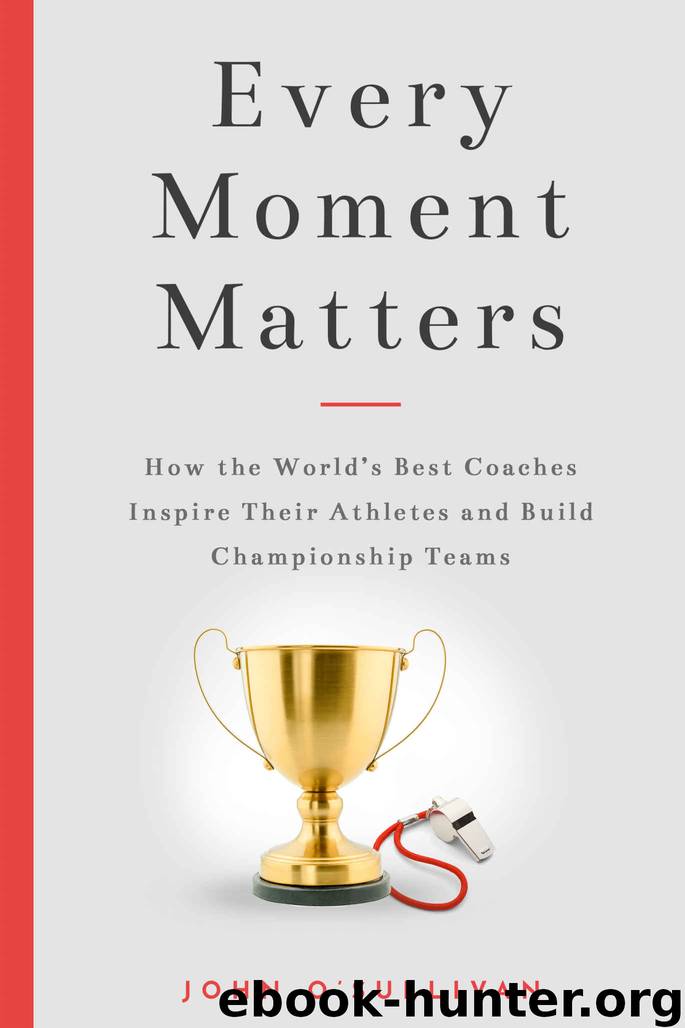Every Moment Matters: How the World's Best Coaches Inspire Their Athletes and Build Championship Teams by John O'Sullivan

Author:John O'Sullivan [O'Sullivan, John]
Language: eng
Format: epub
Tags: every moment matters, john o'sullivan
Publisher: Changing the Game Project
Published: 2019-12-09T23:00:00+00:00
Any coach looking at this list would recognize these as helpful traits that would allow an athlete to improve and put in the long hours necessary to get better. They are also developable skills. Coaches need to be stretching mental capacity, teaching athletes how to respond to setbacks, and how to perform under pressure. We need to be teaching our athletes not only technical and tactical skills but equipping them with these PCDEs as well. But when?
In the second phase of their work, MacNamara, Button, and Collins found evidence that suggests that not only were PCDEs important throughout development, but the manner by which they were deployed depended on the stage, domain, and characteristics of the individual performer. For example, early on, athletes might need the support of parents, coaches, and teachers to reinforce the PCDEs, but as they get older, they must become intrinsically motivated to develop them. “Since the goal of talent development (TD) is to provide the most appropriate learning environment to realize an individual’s potential to excel,” they write, “it is surprising that these crucial determinants of development are consistently overlooked.”
Expert performance, then, is not simply a hardware issue. Elite performers are motivated to consistently take advantage of the development opportunities put before them, yet how often do we fail to evaluate these PCDEs? “By recognizing the multiple factors that influence development,” they conclude, “the efficiency of (talent identification) models is increased by neither excluding ‘potential’ through inappropriate early identification measures, nor ignoring crucial talent development variables that contribute toward the fulfillment of potential.”11 In other words, we must start truly identifying talent, using a definition similar to Armstrong’s Talent Equation, and stop merely selecting it by looking at ability and, more often than not, maturity.
Download
This site does not store any files on its server. We only index and link to content provided by other sites. Please contact the content providers to delete copyright contents if any and email us, we'll remove relevant links or contents immediately.
Unstoppable by Maria Sharapova(3118)
The Inner Game of Tennis by W. Timothy Gallwey(2990)
Urban Outlaw by Magnus Walker(2949)
Crazy Is My Superpower by A.J. Mendez Brooks(2860)
The Social Psychology of Inequality by Unknown(2309)
The Fight by Norman Mailer(2158)
Unstoppable: My Life So Far by Maria Sharapova(2128)
Going Long by Editors of Runner's World(1920)
Accepted by Pat Patterson(1917)
Motorcycle Man by Kristen Ashley(1860)
The Sports Gene: Inside the Science of Extraordinary Athletic Performance by David Epstein(1821)
The Happy Runner by David Roche(1819)
Backpacker the Complete Guide to Backpacking by Backpacker Magazine(1815)
Sea Survival Handbook by Keith Colwell(1794)
Futebol by Alex Bellos(1784)
Mind Fuck by Manna Francis(1743)
Peak: Secrets from the New Science of Expertise by Anders Ericsson & Robert Pool(1662)
Endure by Alex Hutchinson(1604)
The Call of Everest by Conrad Anker(1549)
